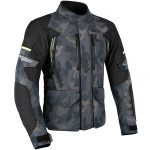Oxford’s Calgary 2.0 textile jacket promises an unusual combination of waterproofing and direct ventilation, without going to the expense of laminated kit.
I was able to test it on a 16-day tour of the Indian state of Kerala, where I needed to stay comfortable when riding in the heat of the coast, the cool of the mountains - and with a constant threat of rain.
The new Oxford Calgary 2.0 seemed to be a good option, and I hoped the environment would be ideal to test the claims made for the jacket and matching trousers, which I wore in combination.
Its direct venting claims come because Oxford have perforated the waterproof membrane in the areas behind the vents, allowing it to breathe in a way that’s not possible in a jacket with a regular drop liner.
My Keralan trip covered 700 miles, which doesn’t sound like much in 16 days to riders who know what’s possible when riding in Europe. It’s different in India, where sometimes a full day in the saddle can see you ride only 60 miles.
You need plenty of stops to recover from weaving through an endless mass of buses, lorries, cars, small scooters and bikes that seem to be coming at you from every direction. The only rule on Indian roads is ‘there are no rules’.
My choice of motorcycle jacket needed to keep me comfortable in the heat at the coast, the cool of the mountains, also rain is always possible, so it needed to keep me dry. Despite feeling I’d need kit to cover a range of temperatures and conditions, temperatures went over 30°C and I had more opportunity to test the effectiveness of the air intakes.
The two ventilation vents at the front and matching pair on the rear are all opened with zips. Oxford say the two front vents are on the chest, however in my view that’s not the case - I’d say they are closer to the armpits. When riding, with arms stretched out to the handlebars, the two front vents closed and became totally ineffective for me.
It’s hard to detect warm air flowing through vents, so I tested this again when I returned to the colder UK weather. I left the vents open to see if I could feel a cold draught and I still couldn’t really feel anything more than a very slight draft to my armpits and a slightly cooler back. This test confirmed my feeling that the front vents were positioned in the wrong place, which makes them ineffective.
Thankfully I can be more complimentary about the Calgary 2.0’s ability to keep out water. Again, this meant testing back at home, because it didn’t rain when I was in India. A shift riding for the Lincolnshire Emergency Blood Bikes Service gave me a 150-mile outing with consistent spells of rain throughout. It was enough for me to say this jacket lives up to its waterproof billing, including the external pockets as they kept their contents completely dry.
Photography: Jose Mas
Speaking of pockets, the two that sit low on each side of the jacket are good-size bellows style pockets that expand to fit my wallet, passport, suntan cream and hand gel.
There are two small pockets on the chest, which I initially thought were air vents, and an inside pocket behind the storm flap and front zip, which is a good place to keep my phone. I would prefer this pocket to be immediately behind the storm flap rather than being inside the front zip as well, which would allow access to the pocket without opening the front zip. Inside there are two net pockets with an elasticated top, one of which is in the thermal liner, and on the rear is a large pocket like the one found on many jackets.
In terms of adjusting fit, elasticated cords tighten the bottom hem and straps tension the jacket on either side of the waist. These straps didn’t stay tensioned for me and needed regular adjustment, though this was not a big deal as they were easy to adjust.
Additionally, two tensioning straps on each arm, above and below the elbow armour, can be adjusted with press studs and help the armour stay in place if you have a fall.
There is a gusset and Velcro strip on the wrist so the width can be adjusted to a fit over or under gloves.
The collar has two press studs so the diameter can be altered, though there is not enough adjustment on this strap to suit all the layers I wear in colder weather. A hook and eye means the flap can be fastened back for more ventilation.
Inside, there’s a removable thermal liner. It has an overlapping flap at the front to give a complete thermal lining when the jacket is closed, though in my experience this didn’t fully cover the front, which left a cold spot. The liner improved the warmth of the jacket, however additional layering was needed in the UK to keep me comfortable when the temperature was around 5°C.
The jacket is supplied with elbow and shoulder armour that’s rated at CE Level 1 and it has an overall CE approval rating of AA. A pocket is provided for the optional back protector, though this has to be purchased separately.
Overall, I found the Calgary 2.0 comfortable and easy to live with on the road, and it’s lightweight compared to many jackets. My biggest criticism is of poor ventilation, which in my opinion is down to the front vents being positioned near to my armpits, not on my chest. The rear vents are large and I am sure that if air could get into the jacket at the front it would be able to flow out of the rear and give a cooling breeze.










